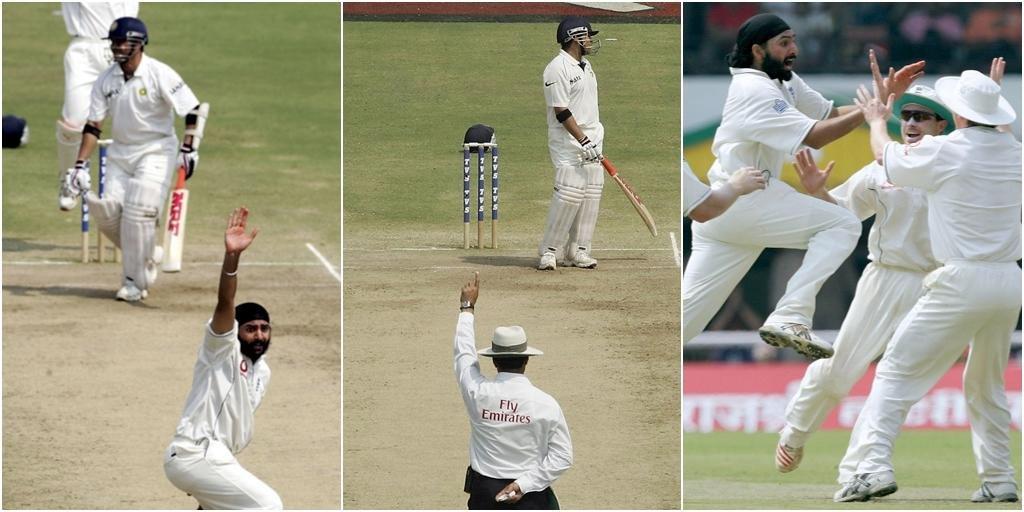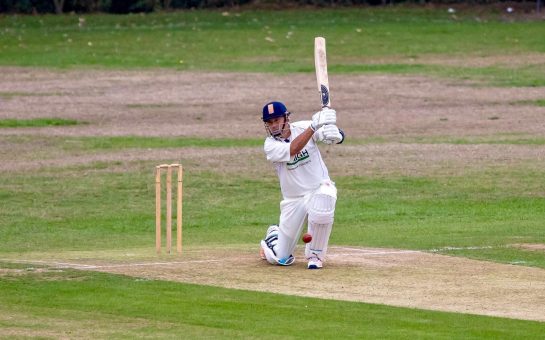“I think in life, people get exhausted by the time they reach their goal and they forget to celebrate. It’s important to celebrate your successes in life. I really celebrated that moment, I really enjoyed that moment of playing Test cricket, you know.”
When asked how he’d like to be remembered as a Test match cricketer, Monty Panesar emphasises his love for the game. For anyone who followed the England cricket team during the 2000s and early 2010s, this was evident.
A cult figure within the sport and a key member of the England team, his wily left-arm spin, exuberant celebrations and evident love for the game garnered recognition within the sport, before he became a household name – a rare feat for a cricketer.
Chatting to Panesar about his career, and cricket in general, for the best part of an hour is both an insightful and truly surreal experience. His passion for cricket and knowledge of the game come alive as soon as he answers my first question, but, for me to be interviewing Panesar, whose international career took place throughout my youth, feels somewhat implausible.
After falling for the game of cricket as an eight-year-old in the glorious summer of 2005, the England cricket team became one of my many childhood sporting obsessions, and Panesar, who made his Test debut in 2006, was soon to become integral to that team. He offered something that the team had lacked for quite a while – he was a spinner who could actually turn the ball.
Panesar’s rise was meteoric – less than six months into his international career, the then-England coach Duncan Fletcher called him the “best finger spinner in world cricket”. Shortly after, his debut international season was marked by being named one of the five cricketers of the year by Wisden.
As the England team moved through different coaches, and partly due to the emergence of Graeme Swann, Panesar became less of a fixture in the England eleven – a squad player who played as a second spinner to Swann when conditions suited. His fiftieth and last Test came against Australia in December 2013, by which point he had taken 167 wickets.
He speaks with pride about his international career, and our interview starts at its beginning – his debut on tour to India back in March 2006, under the temporary captaincy of Andrew Flintoff. Fresh from his Ashes heroics, ‘Freddie’ was at the peak of his powers, and Panesar has nothing but praise for the Lancashire man.
He says: “At first I felt like I shouldn’t be there. I didn’t really expect to play any of the Tests, I thought I was just there to learn and maybe not play just yet, but Freddie backed me. He backed my attitude, how I was as a bloke, everything about me and I will always thank him for that. Otherwise I would never have had all the other stuff that happened in my career.”
“Freddie was very into the game, he was always switched on. He felt like he had to take the burden of responsibility for everyone as well, so he was very much a leader from the front. You know, how Superman does everything, well Freddie was like that. He’s got this amazing willpower.”
Panesar took five wickets across the three match series, including claiming his childhood hero Sachin Tendulkar as his first Test wicket, as England secured a 1-1 draw. Yet it was the following summer when, under the leadership of regular skipper Michael Vaughan, that he was to establish himself as a key member of the England eleven.
“I think Vaughan was really good at helping me just bowl. He’d say ‘just go and bowl mate, don’t worry about anything else’. He knew that I loved bowling and he’d say ‘here’s the ball, spin it for me’. And that was it – that just really helped me to go out and take wickets.”
The wickets did come. Playing all seven home tests in 2006, Panesar was England’s highest wicket taker, taking 27 at an average of 26.85. In a similar vein to Vaughan’s captaincy, he credits the laissez-faire approach of England coach Duncan Fletcher with bringing the best out of him.
“Duncan was one of the best coaches I came across. He didn’t speak to me much, he let me do my thing and let me work out the answers. He gave me the space and honestly believed I had some talent in me.
“It allowed me to just take the challenge of playing for England in my stride. I didn’t really think about it too much. For me, whatever chance they gave me, I wanted to take it to the best of my ability and they ended up giving me more and more responsibilities. It developed into Vaughany saying: ‘I trust Monty to take wickets and win a Test match for me’.”
With success that summer came Fletcher’s glowing praise, as well as recognition from Wisden, which was a surprise for a man who, not long before, felt out of place in international cricket.
“I never thought that I would be a Wisden cricketer of the year, I never thought that I had that level of performance in me. When I was younger I probably didn’t back myself enough. I would always need other people’s reassurances and other people saw a bigger and better cricketer in me than I saw in myself. I never thought I would be a Wisden cricketer of the year, that was never even a dream for me.”
After Panesar’s great season, England endured a torrid winter. A 5-0 Ashes defeat in Australia was followed by a terrible 2007 World Cup. It culminated in Fletcher departing, replaced by Peter Moores as coach. Panesar cites this as a significant moment in his career.
“I think the ability that the likes of Alastair Cook, Jimmy Anderson, Stuart Broad had meant that they were very good at adapting with each coach, but I wasn’t. When Peter Moores came, he was very much a hands-on coach, he very much wanted to know my processes and everything, but I didn’t even know what a process was. I would just bowl. I worked best when I was just left to it.”
However, possibly in spite of Moores’ ‘processes’, Panesar kept performing. He took 31 wickets in 7 Tests during the 2007 season, including 10 in the Third Test against West Indies at Emirates Old Trafford. It was a fruitful ground for Panesar, who claimed 25 wickets in his three Tests at Lancashire’s home, making him the fourth highest Test wicket-taker there. The enthusiasm with which he talks about spin bowling goes up a gear when asked about the pitch at Old Trafford.
“I always ask Glen Chapple (Lancashire coach) if he wants a spinner. Lancashire is one place that I would love to play cricket. The pitch is just suited to my bowling, it’s tailor made.
“I think I spun England to victory there every time I played at Old Trafford, bowling there was just natural. If I could wrap that pitch up and take it with me, every time I would say that I would win you a game on it.
“I tended to bowl it quite quickly and the pace of the pitch suited my bowling. My best performances came there – taking 10 in the match against West Indies and the 6/37 against New Zealand the following summer.”
Despite these spells, which cemented Panesar as a match-winner, he recognises that his most famous England performance did not come with the ball in hand. Instead, his defiant batting with James Anderson to save a draw in the Cardiff Ashes Test in 2009 is, in his own words, his “finest hour in an England shirt.”
England were thoroughly outplayed in that Test, with Australia scoring a mammoth 676/6 to lead by 239 runs. Not known for his batting, last man Panesar joined fellow tailender Anderson at the middle, with England requiring six runs to merely make Australia bat again. The priority, however, was to see out the day and deny Australia a victory.
Amazingly, the pair batted for over 40 minutes, scoring just 19 runs, but keeping the Australia attack at bay, with every leave and defensive shot was cheered as if it were a boundary. Escaping with that draw in that First Test allowed England to go on and win the series 2-1, which Panesar looks back on with pride.
“I’m known for my bowling and I felt that was my finest hour for England, let’s be honest.
“We both just took it ball by ball. Jimmy is Jimmy, you know, he just said ‘take it ball by ball mate, let’s see where it takes us’. We didn’t expect anything of it and it went ball by ball. I’m very proud that our batting and holding on in Cardiff was pivotal to England winning that series.”
Panesar, however, did not play again in that Ashes series, with his former Northamptonshire colleague Graeme Swann preferred as the first-choice spinner by new coach Andy Flower. This was to influence the remainder of his international career.
Flower’s side were to achieve greatness, rising to number one in the Test world rankings after beating India 4-0 at home in 2011. Under his leadership, the side also enjoyed their first Ashes victory in Australia since 1987 and first series win in India since 1985. Though he wasn’t playing as often, Panesar recognises the incredible achievements of that period.
“Andy did a lot for English cricket. He was fully behind the idea of taking this team to number one. He’d find out about each problem, about each bowler and ask ‘why can’t he swing it?’ He’d ask why batters couldn’t leave the ball when it was swinging, he’d ask the spinners why we weren’t turning the ball when it’s flat. He would challenge you with these questions and ask how are we going to overcome these problems and beat the best teams?
“I wasn’t really involved that often, but Andy made the squad feel like you were part of the eleven. When we won the Ashes in Sydney in 2011 and I sat with the group, I felt like I was truly part of the team despite not playing any Tests in that series. That was one of the other reasons why we became number one, Andy would always make the squad members feel included.”
“I thought me and Andy were good mates, he always said to me ‘Monty, you’ve got healthy competition now, Swanny is a better all-round cricketer – he can bat, he’s got good hands in the slips’. My fielding wasn’t great, I wasn’t that athletic. Bowling wise, Swanny and I were probably similar, but he just warned me that it could be quite difficult, he was honest and fair as a coach.”
“I began to realise early on that maybe I was going to be the second spinner, maybe because my batting wasn’t as good as Swanny’s. When England were five down for 100-odd, they always pulled themselves back up to 250, 300, with Swanny smashing it around. He loved the freeness of just going out there and whacking it.”
Nonetheless, Panesar relished bowling with a fellow spinner. His partnership with Swann was key to victory in India in 2012. Panesar took 17 wickets in three Tests, while Swann took 20 in four, as England became the first away team to beat India in a Test series since 2004. There’s evident regret that it didn’t happen more often, but Panesar, like all of his career, looks back fondly at bowling in tandem with another spinner.
“You know how Wasim Akram and Waqar Younis had that competition, if you take a wicket then next over I’m going to take a wicket? It was a little bit like that when we were together.
“We thrived off each other – I loved bowling with Swanny. I played with him at Northamptonshire, but I wish we could have played home and away together for England regularly. We didn’t really have an all-rounder at that time, I just wish Ben Stokes was around earlier. We needed an all-rounder like him and then me and Swanny could have played home Tests as well.”
His time as an England player came to an end in 2014, as part of a side which lost 5-0 in Australia and subsequently saw several changes in personnel. Nonetheless, Panesar’s memories of his international career are not tinged with regret, nor should they be.
A key figure in the revitalisation of English spin bowling, he played 50 Tests, bowled his side to numerous victories and was part of a very bright era for the national team, and it’s evident that he recognises this.
When asked how he wanted to be remembered as a Test cricketer, Panesar said he wanted to be seen as someone who took challenges head on, but who also loved the game and truly celebrated reaching its peak.
“It’s important to celebrate your successes in life”, he says. “People get exhausted by the time they reach their goal and they forget to celebrate.”
Wheeling in delight after taking a wicket, with a jump thrown in for good measure, is the enduring image of Panesar the cricketer. So, I guess he has his wish.

Header image courtesy of ICC on Twitter, with thanks



